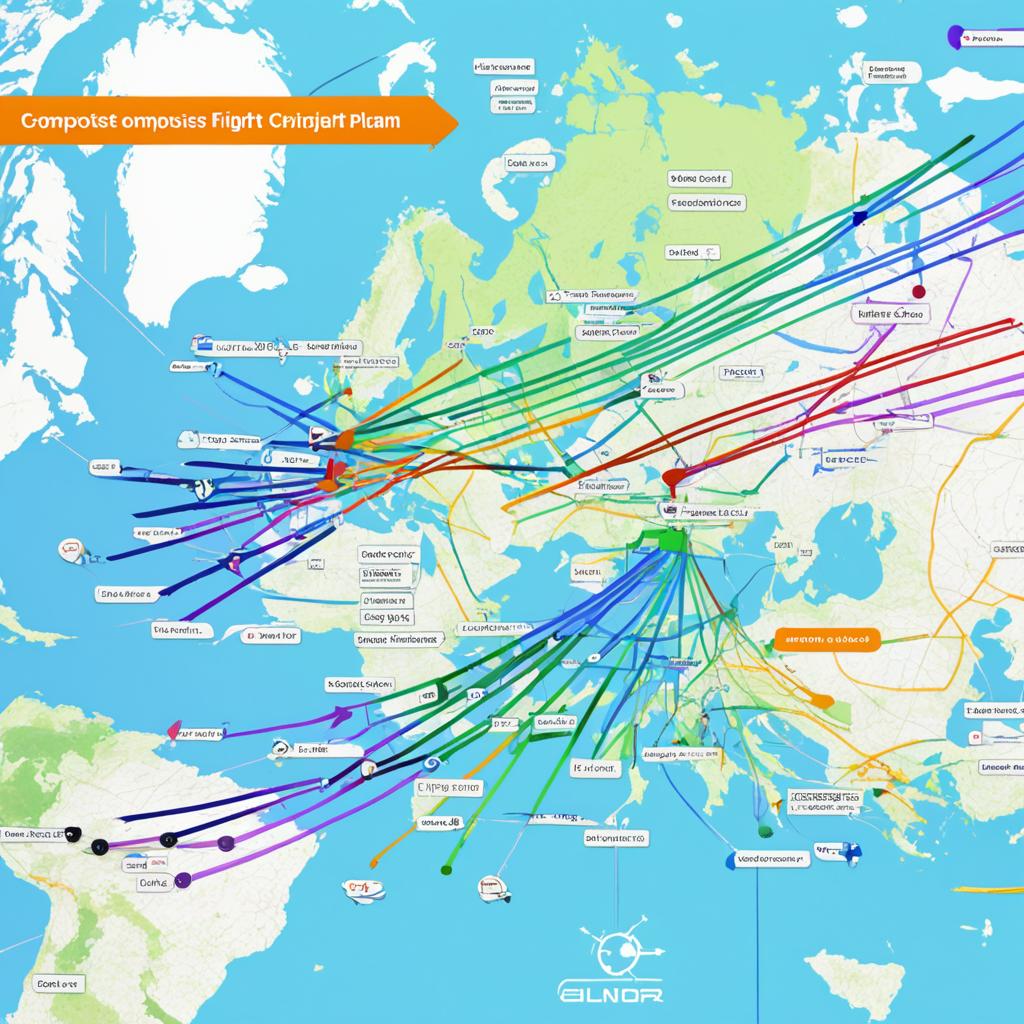Have you ever wondered how pilots navigate through changing weather conditions during a flight? How do they seamlessly transition from relying on visual cues to relying solely on instruments? The answer lies in a fascinating concept called the composite flight plan.
As an aircraft dispatcher, understanding the intricacies of flight planning is essential to ensure the safety and efficiency of every journey. But what exactly is a composite flight plan, and how does it enable pilots to navigate through varying weather conditions?
Let’s dive into the world of composite flight plans and discover how they play a crucial role in aviation.
VFR Flight Planning
When it comes to flight planning, visual flight rules (VFR) play a crucial role in ensuring a safe and efficient journey. VFR flight planning is based on the principle of maintaining clear visual contact with the ground and other aircraft during the flight. This type of flight is typically conducted in fair weather conditions and for shorter distances.
One of the key factors in VFR flight planning is flight visibility, which refers to the distance a pilot can see ahead and around the aircraft. Pilots must ensure that the flight visibility is not less than the prescribed limits for the corresponding altitude and class of airspace.
By adhering to VFR flight planning, pilots are able to navigate using visual cues such as landmarks, roads, and bodies of water. This approach allows for greater situational awareness and flexibility during the flight.
Understanding and following visual flight rules is essential for pilots operating under VFR conditions. It empowers them to make informed decisions based on weather conditions and flight visibility, ensuring a safe and enjoyable flight experience.
| Key Considerations for VFR Flight Planning |
|---|
| 1. Weather Conditions |
| 2. Flight Visibility Requirements |
| 3. Visual Navigation |
| 4. Situational Awareness |
IFR Flight Planning

When it comes to commercial flights and flying in instrument conditions, IFR flight planning is crucial. Unlike VFR flights that rely on visual cues, IFR flights operate solely based on instrument flight rules and sophisticated aircraft instruments. Pilots in IFR flights heavily depend on the airplane’s instruments and require assistance from knowledgeable air traffic controllers.
IFR flight planning is essential for pilots due to its unique characteristics and requirements. Pilots flying in instrument meteorological conditions (IMC) undergo additional training to master IFR operations. This training ensures they have the necessary proficiency to interpret instrument readings accurately and make informed decisions.
Pilots must file an IFR flight plan before departure to establish a clear understanding of the intended route and altitude with air traffic control (ATC). This flight plan includes details such as the aircraft type, intended destination, estimated time of departure (ETD), route, and desired altitude.
| Key Components of IFR Flight Planning: |
|---|
| 1. Filing an IFR flight plan with ATC |
| 2. Understanding and interpreting instrument readings |
| 3. Communication and coordination with air traffic controllers |
| 4. Adherence to IFR procedures and regulations |
| 5. Utilizing advanced aircraft instruments |
Overall, IFR flight planning requires meticulous attention to detail and compliance with the instrument flight rules. Pilots must possess the necessary skills, training, and equipment to navigate through instrument conditions safely and efficiently.
Advantages of IFR Flight Planning:
- Enhanced safety: IFR flight planning reduces the risk associated with low visibility and adverse weather conditions.
- Increased flexibility: Pilots can fly in a wider range of weather conditions and adapt their route as necessary.
- Efficient navigation: Relying on instrument readings and air traffic controllers’ guidance enables precise navigation and helps avoid collisions.
- Access to different airports: IFR flight planning facilitates landing at airports that may have fewer visual navigation aids and operate under IFR procedures.
Composite Flight Plans
Composite flight plans offer a versatile solution for flights operating in mixed weather conditions. These plans combine elements from both VFR (Visual Flight Rules) and IFR (Instrument Flight Rules) flight plans, providing pilots with the flexibility to adapt to changing weather and flight conditions.
Imagine you’re embarking on a journey where the weather is unpredictable. You start in clear VFR conditions, but as you progress, you encounter dense fog or thunderstorms. This is where a composite flight plan comes into play. By filing a composite flight plan, you can seamlessly transition between VFR and IFR flight rules, ensuring safety and adaptability throughout your journey.
Flexibility is key in aviation, and composite flight plans offer just that. They allow pilots to make real-time decisions based on the prevailing weather conditions or changes in visibility. Whether it’s a sudden change in weather or the need to avoid congested airspace, composite flight plans enable pilots to navigate through various scenarios with confidence.
A composite flight plan not only enhances safety but also maximizes efficiency. By utilizing both VFR and IFR flight rules, pilots can optimize their routes and take advantage of favorable conditions. This strategic approach can minimize delays and fuel consumption, resulting in cost savings and improved operational performance.
In situations where a flight encounters sub-optimal weather conditions for a portion of the journey, composite flight plans prove invaluable. Pilots can adjust their flying strategy to ensure a smooth and safe flight, even when faced with challenging weather or visibility conditions.
Remember, aviation is an ever-changing environment, and being prepared for all possibilities is crucial. By utilizing composite flight plans, pilots can confidently navigate through mixed weather conditions, demonstrating the benefits of adaptability, safety, and efficiency.
Next, we’ll explore the unique considerations and requirements of defense VFR flight plans, which are essential for flights operating within military zones and air defense identification zones (ADIZ).
Defense VFR Flight Plans

Defense VFR flight plans play a crucial role in ensuring the safety and compliance of flights within air defense identification zones (ADIZ) and military zones in Canada and the United States. These specialized flight plans are essential when a flight needs to deviate into a military zone, providing coordination and adherence to military regulations throughout the journey.
Flights near sensitive areas or during times of heightened security require defense VFR flight plans to maintain strict compliance and minimize risks. By filing these flight plans, pilots can ensure smooth coordination with military authorities and navigate through military zones while adhering to established protocols.
Defense VFR flight plans assist in safeguarding airspace integrity and contributing to national security efforts. These flight plans are particularly important when operating near air defense identification zones (ADIZ) and within military zones, as they help pilots make informed decisions while respecting military airspace boundaries.
Adhering to defense VFR flight plans ensures compliance with military regulations and contributes to the overall safety and security of air travel in sensitive areas. By following these protocols, pilots can effectively navigate through military zones while minimizing disruptions and maintaining situational awareness.
To illustrate defense VFR flight plans and their importance, the table below provides a comparison of key attributes:
| Defense VFR Flight Plans | Regular VFR Flight Plans |
|---|---|
| Specific to air defense identification zones (ADIZ) and military zones | General flight plans for visual flight rules |
| Coordination with military authorities | No specific coordination with military |
| Compliance with military regulations | Compliance with civil aviation regulations |
| Restricted access to military zones | No restrictions in non-military zones |
| Enhanced situational awareness in sensitive areas | Situational awareness based on general weather conditions |
International Flight Plans
When it comes to cross-border flights and navigating through different countries, international flight plans play a crucial role in ensuring a smooth and compliant journey. These flight plans are designed to adhere to the specific rules and regulations of each country the aircraft will transit. As a pilot, it is essential to be familiar with the requirements and procedures of each country you will be flying over.
International flight planning involves coordinating with international authorities and may require additional documentation or clearances. This process ensures that you have all the necessary approvals and permits to operate within the airspace of foreign nations. By following the international flight planning protocols, you contribute to the safety and efficiency of your flight, minimizing any potential issues or disruptions.
An important aspect of international flight plans is understanding the unique requirements of different countries. These requirements can vary in terms of communication procedures, airspace restrictions, navigation aids, and more. It is vital to thoroughly research and prepare for these variations to ensure a seamless transition through international airspace.
In addition to complying with regulations, international flight plans offer distinct advantages for cross-border flights. They provide pilots with a structured route and help optimize fuel consumption and flight time. Having a well-designed international flight plan allows for better coordination with air traffic control and the efficient use of airspace resources.
Let’s take a look at a table that highlights some key differences in rules and regulations for international flight plans across different countries:
| Country | Airspace Restrictions | Communication Procedures | Navigation Aid Usage |
|---|---|---|---|
| United States | No-fly zones near sensitive areas | Frequent ATC communication required | Wide usage of GPS navigation |
| Canada | Avoidance of military zones | Clearance from military authorities required in certain areas | Reliance on VOR and NDB navigation |
| United Kingdom | Strict adherence to specific flight corridors | Preferential use of assigned frequencies | Primarily rely on RNAV equipment |
By understanding and following the rules and regulations set by different countries, you can safely navigate international airspace and optimize your flight operations. Remember to consult the appropriate aviation authorities and plan your international flight carefully to ensure a successful and hassle-free journey.
Importance of Flight Planning
Flight planning is a critical aspect of aviation that ensures the safety and efficiency of aircraft operations. Whether it’s a commercial flight or a private journey, proper flight planning is essential for a smooth and secure passage from one location to another.
By engaging in thorough flight planning, pilots can assess current and forecasted weather conditions, plan suitable routes, and make necessary adjustments to ensure the safety of both the passengers and the aircraft. This includes considering factors such as wind speed, temperature, and potential hazards along the way.
Aircraft dispatchers, who are responsible for coordinating flight operations and managing logistics, play a crucial role in developing comprehensive flight plans. They consider various weather patterns and flight zone considerations to create customized plans that minimize risks and ensure compliance with FAA regulations.
Furthermore, flight planning enhances the overall efficiency of air travel. By optimizing routes, pilots can reduce fuel consumption, save time, and enhance the overall performance of the flight. This not only benefits the airline in terms of cost savings but also contributes to the industry’s efforts towards sustainability by reducing carbon emissions.
To become proficient in flight planning, aspiring aviation professionals can pursue education at accredited aircraft dispatching schools. These institutions provide the necessary training and knowledge to develop effective flight plans and navigate the complex world of aviation operations.


